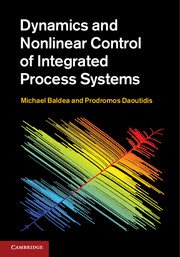1 - Introduction
from Part I - Preliminaries
Published online by Cambridge University Press: 05 September 2012
Summary
Integrated process systems, such as the one in Figure 1.1, consisting of multiple reaction and separation units, heat integrated and interconnected through material recycle streams, represent the rule rather than the exception in the modern process industries. The dynamics and control of such systems present distinct challenges: in addition to the nonlinear behavior of the individual units, the feedback interactions caused by the recycle connections typically give rise to a more complex, overall process dynamics. The use of design modifications, such as surge tanks and unit oversizing, and the choice of mild operating conditions, preventing the propagation of disturbances through the plant, initially allowed the problem of controlling chemical plants with material recycling to be dealt with at the unit level, using the “unit operations” approach (Umeda et al. 1978, Stephanopoulos 1983): control loops were designed for each unit, their tuning being subsequently adjusted to improve the operation of the entire plant. However, the shortage of raw materials, rising energy prices, and the need to lower capital costs have, over the past few decades, spurred the process industry's tendency to build “lean,” integrated plants, relying heavily on material recycles and energy recovery.
Owing to dwindling fossil-fuel supplies (and the associated increase in the cost of energy), improving energy efficiency has become particulary important. Energy integration and recovery are key enablers to this end. Fundamentally, energy integration involves identifying the energy sources and sinks within a system and establishing the means for energy transfer between them, thereby reducing the use of external energy sources and utility streams. Chemical reactors and distillation columns inherently contain such sources and sinks and clearly constitute prime targets for energy integration.
Information
- Type
- Chapter
- Information
- Publisher: Cambridge University PressPrint publication year: 2012
